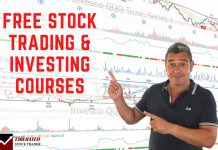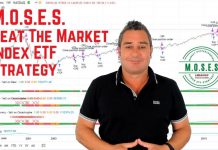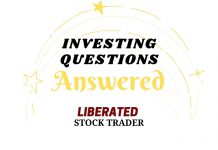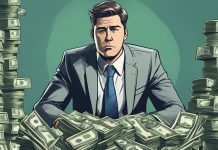Reverse stock splits are typically undertaken by companies seeking to boost their stock price by reducing the number of outstanding shares.
☆ Research You Can Trust ☆
My analysis, research, and testing stems from 25 years of trading experience and my Financial Technician Certification with the International Federation of Technical Analysts.
Often seen as a sign of weakness, it attracts short-sellers attempting to profit from statistically proven future price declines.
We’ll take a comprehensive look at reverse stock splits, their definitions, how they work, and the strategies used to profit from them.
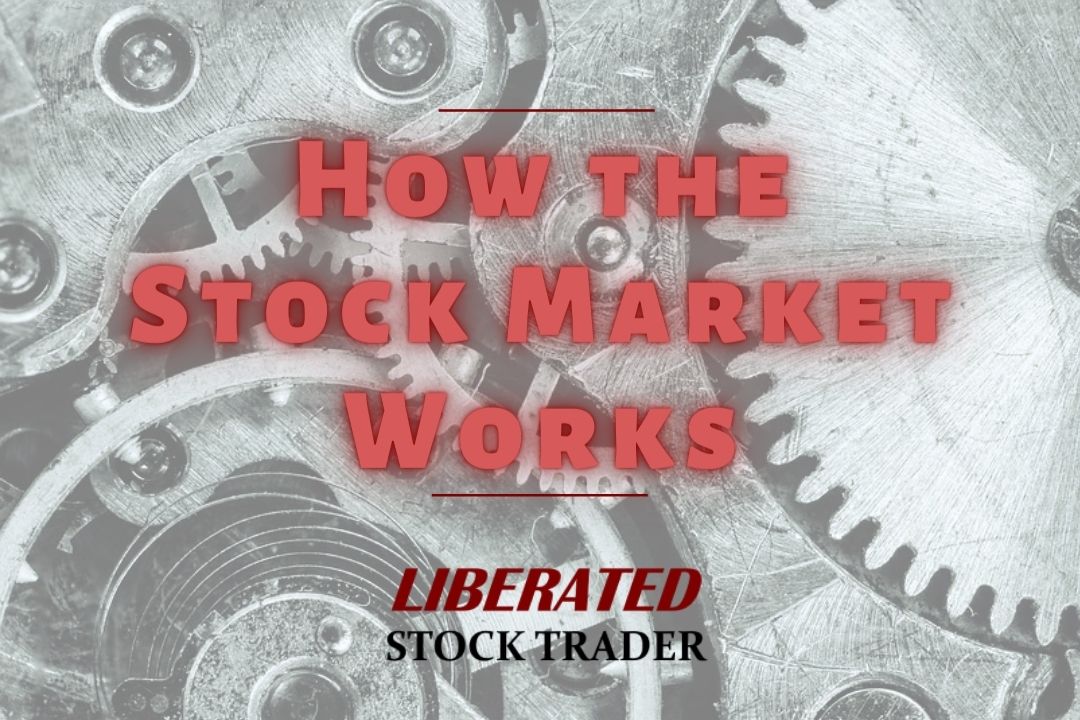
What is a Reverse Stock Split?
A reverse stock split is a corporate action in which a company reduces the total number of its outstanding shares. It is more like a stock merger; a 1-for-2 reverse split means each shareholder will own one share for every two shares they owned before the split. This action should correspond to a doubling of the share price.
Example
A reverse stock split is when a company reduces the total number of outstanding shares. For example, if a company has one million outstanding shares and declares a 1-for-10 reverse stock split, the company will have 100,000 outstanding shares after the split. In other words, each shareholder will own one share for every ten shares they owned before the split.
Pros
Increase Price per Share
The primary benefit of a reverse stock split is that it can potentially increase the price of a company’s shares. Reducing the number of outstanding shares increases the demand for those remaining shares; however, this can be a double-edged sword as it may also lead to decreased liquidity for shareholders. Fewer shares outstanding means lower liquidity.
Stock Exchange Requirements
Another benefit is that it can help the company stay within certain stock exchange requirements, such as maintaining a minimum share price.
Reduce Transaction Costs
Reverse stock splits can also potentially reduce the transaction costs of buying and selling shares. The fewer outstanding shares, the lower these costs may be.
Increase Credibility
The perception of a higher stock price can increase investor confidence in a company and make it appear more attractive to potential investors. This could lead to increased institutional ownership and better access to capital.
Reduce Shareholder Dilution
The reverse stock split also reduces shareholder dilution, which occurs when a company issues additional shares of its common stock to the public. By reducing the number of outstanding shares, companies can avoid this form of dilution and protect shareholders’ investments.
Cons
Reduced Demand
Some investors see reverse splits as a sign of competitive or financial weakness and avoid buying shares in companies that undergo them.
Stock Price Weakness
Research shows there is no guarantee that a reverse split will achieve a sustained increase in stock price. This means that investors may find themselves in a position where they have bought shares at an artificially high price, and then, after the reverse split, the share prices drop again.
A Sign of Desperation
Because reverse splits are often done by companies whose share prices have fallen precipitously, doing one can be viewed as a sign of desperation. This negative perception can further pressure the share price down after the announcement of the split.
Example Chart: Reverse Stock Splits Force Prices Lower
Abeona Therapeutics (NASDAQ: ABEO) continues lower after a large 25-for-1 reverse stock split. This demonstrates how short sellers are attracted to reverse split companies, forcing lower prices.
Why Do Companies Do Reverse Stock Splits?
The purpose of a reverse stock split is to increase the per-share price so that the company can be traded on a major exchange. For example, the minimum price per share to be traded on the Nasdaq is $1. A company trading below $1 can do a reverse stock split to meet this listing requirement to increase the per-share price.
While most people think of stock splits as something that only happens when a company’s share price gets too high, there are a few reasons why a company might opt to do a reverse stock split.
5 Reasons for Reverse Splits
Companies reverse stock splits to boost share price and investor confidence and to improve liquidity while lowering transaction costs.
- The most common reason is to increase the per-share price so the company can list on a major exchange.
- To boost investor confidence: If a company’s stock price has fallen significantly, doing a reverse stock split can make it look more attractive and give investors confidence in its prospects.
- Another common reason for doing a reverse stock split is to increase liquidity; because investor demand tends to be higher for stocks with higher prices, companies will sometimes do reverse splits to increase trading activity and generate interest in their stock.
- To make buying and selling shares easier: When the per-share price is too low, it can be difficult for brokers to execute trades without incurring significant losses. By doing a reverse stock split, brokers can buy and sell shares more easily without taking as much risk.
- To save on transaction costs: When a company has millions of outstanding shares, it can incur significant costs every time it buys or sells shares of its stock. A reverse stock split decreases the number of shares, which reduces transaction costs.
How Do They Work?
A reverse stock split is when a company reduces the number of shares outstanding while proportionately increasing the share price. For example, if a company does a 1-for-2 reverse stock split, each shareholder would end up with half as many shares as they owned before, but the price of each share would double.
Example: What happens in a reverse stock split?
Let’s use an example to illustrate how reverse stock splits work in practice. Imagine X Corp. has 1 million shares outstanding, each trading for $10 per share. After a 1-for-2 reverse stock split, ABC Corp would have 500,000 shares outstanding, each trading for $20.
So even though shareholders would own half as many shares as they did before the split, the cost basis of their investment would remain unchanged because the total value of their holdings (i.e., the number of shares times the price per share) would stay the same: 1 million shares x $10 per share = 500,000 shares x $20 per share.
Example: What Happens to Market Cap in a reverse stock split?
Using the same example as above, let’s take a look at what happens to X Corp.’s market capitalization after doing a 1-for-2 reverse stock split:
Before the Reverse Stock Split
X Corp. had 1 million shares outstanding x $10 per share = $10 million in total market capitalization.
After the Reverse Stock Split
X Corp. has 500,000 shares outstanding x $20 per share = $10 million in total market capitalization.
As you can see, the market capitalization remains unchanged even though there are now half as many shares outstanding because each of the remaining shares costs twice as much as before. This means that while investors may be reluctant to buy stocks that have undergone a reverse split, the effect on market capitalization is often negligible.
The main purpose of a reverse stock split is to increase the price of the shares by reducing the number of outstanding shares, thus making each share cost more. Depending on the circumstances, this can benefit shareholders, improve liquidity, and make their stocks more attractive to potential investors.
You want to be a successful stock investor but don’t know where to start.
Learning stock market investing on your own can be overwhelming. There’s so much information out there, and it’s hard to know what’s true and what’s not.
Liberated Stock Trader Pro Investing Course
Our pro investing classes are the perfect way to learn stock investing. You will learn everything you need to know about financial analysis, charts, stock screening, and portfolio building so you can start building wealth today.
★ 16 Hours of Video Lessons + eBook ★
★ Complete Financial Analysis Lessons ★
★ 6 Proven Investing Strategies ★
★ Professional Grade Stock Chart Analysis Classes ★
Example HMNY Reverse Stock Split Chart
This chart from Helios and Matheson Analytics illustrates that a reverse stock split alone cannot rescue a failing company. The company underwent a split in July 2018, resulting in a decline in stock price to $0.01 per share. It serves as a reminder that sustainable business success goes beyond mere stock manipulation.
Despite a substantial increase in per-share price, it proved unsustainable and eventually plummeted to a mere $0.01 per share. This chart serves as a poignant reminder of the significance of thoroughly researching a company before investing, illustrating how even a reverse stock split may fall short in rescuing a failing business.
Are Reverse Stock Splits a Defense Against Short Sellers?
No, reverse stock splits do not negatively affect short sellers. A common myth is that reverse stock splits can also be used as a defensive measure against short sellers; if short sellers believe that a company’s share price will fall sharply, they may initiate large short positions in anticipation of this drop. If enough short sellers pile into a position, it can drive the price down even further (a phenomenon known as “short selling pressure”).
To combat this pressure and prevent their share price from falling too low, companies sometimes do reverse splits, making it more expensive for short sellers to maintain their positions.
Do Short Sellers Benefit From Reverse Stock Splits?
Yes, short sellers can benefit from reverse stock splits. A 2021 study by Ryan Voges at Utah State University reveals that stock prices get additional downside price pressure 20 days after a reverse stock split because even more short sellers are attracted to the company. In short, after a reverse stock split, “stocks experience negative cumulative abnormal returns.”
Short-selling activity significantly increases for firms that undergo reverse stock splits. Such firms tend to experience negative cumulative abnormal returns within 20 days post-reverse split, particularly if short sellers heavily target them.
Vogues’ findings indicate that short sellers possess valuable information and accurately anticipate future downturns in stock performance. Additionally, the results suggest that short sellers exert downward pressure on stock prices following reverse splits.
How to Profit From Reverse Stock Splits
The best strategy is to short the stock to profit from a stock split. Academic research shows that, on average, stock price declines in the 20 days after a reverse stock split and that the trend continues for 3 years.
A 2018 study by Kim, Klein, and Rosenfeld suggests that short sellers can profit from a reverse stock split because company share prices decline abnormally in the three years after the split is enacted.
The research paper analyzed the long-term returns of more than 1,600 firms that underwent reverse stock splits. It found a statistically significant decline in abnormal returns during the three years following the reverse split.
Following the year of the reverse split, the sample firms consistently performed poorly over the subsequent four years, implying the presence of informational inefficiencies. Further analysis reveals that these stocks possess distinctive financial traits, rendering them highly challenging to sell short. Consequently, arbitrageurs encounter restrictions in their capacity to generate abnormal profits, even with accurate predictions of price depreciation.
Is a reverse stock split a sign of financial weakness?
The literature suggests that a reverse stock split often indicates financial distress. A review of 13 studies found that companies facing liquidity constraints and other cash flow issues tend to utilize reverse stock splits more frequently than their stronger peers.
Moreover, the analysis revealed a negative association between the odds of a firm undertaking a reverse stock split and its ability to pay dividends or meet other obligations. Therefore, investors should know that a reverse stock split may indicate an impending risk of financial distress or insolvency.
Are reverse stock splits good?
Yes and no. A reverse stock split can be a good temporary fix for a corporation seeking to meet exchange requirements. It can also be good for short-sellers. However, a reverse stock split shows weakness in a company’s financials, products, or management team.
If a company were growing and financially strong, it would not have to perform a reverse stock split.
Conclusion
Companies undertake reverse stock splits for various reasons ranging from trying to meet listing requirements on major exchanges to reducing transaction costs incurred from buying and selling shares of their stock.
However, investors should be aware of some disadvantages associated with this type of corporate action before buying stocks that have undergone reverse splits, including the fact that any increase in per-share prices will only be temporary and that reverse splits can sometimes be viewed as a sign of desperation by investors which could pressure the share price lower after the announcement of the split.
In this article, we’ve looked in-depth at reverse stock splits: what they are, how they work, and why companies might choose them. We hope you found this informative!
Investing In Stocks Can Be Complicated, Stock Rover Makes It Easy.
Stock Rover is our #1 rated stock investing tool for:
★ Growth Investing - With industry Leading Research Reports ★
★ Value Investing - Find Value Stocks Using Warren Buffett's Strategies ★
★ Income Investing - Harvest Safe Regular Dividends from Stocks ★

"I have been researching and investing in stocks for 20 years! I now manage all my stock investments using Stock Rover." Barry D. Moore - Founder: LiberatedStockTrader.com
FAQ
What software can track reverse stock splits?
Investors interested in tracking stock splits should consider investing in portfolio management software like Stock Rover. Those interested in trading stock splits should try TradingView.
What is a reverse stock split?
A reverse stock split is a corporate action in which a company reduces the total number of its outstanding shares, thereby increasing the price per share.
Why do companies do a reverse stock split?
Companies typically conduct reverse splits to increase their share price and attract more investors. They may also aim to meet the minimum price criteria for listing on certain stock exchanges.
How does a reverse stock split affect shareholders?
In a reverse split, a shareholder's investment value remains the same, but they end up with fewer shares that are each worth more. However, it's important to note that this doesn't increase the company's value; market capitalization remains the same.
What happens to my shares in a reverse stock split?
In a reverse split, your total number of shares is reduced according to the split ratio. For example, in a 1-for-2 split, you would have one share for every two previously held. The price per share, however, will double.
Is a reverse stock split good or bad?
A reverse split is good and bad. It can help a company avoid delisting but also signals to investors and short-sellers the firm's potential financial difficulties.
What is a typical ratio for a reverse stock split?
Common ratios for reverse splits include 1-for-2, 1-for-5, or 1-for-10, but the exact ratio will depend on the company's specific objectives.
Does a reverse stock split change a company’s market capitalization?
No, a reverse stock split doesn't change a company's market capitalization, as the increase in the share price is offset by an equal decrease in the number of shares outstanding.
Can I lose money in a reverse stock split?
While the reverse split doesn't directly cause you to lose money, it can be a sign of a company's financial distress, leading to future losses and short-selling pressure in the stock.
How is a reverse stock split different from a regular stock split?
In a regular (or forward) stock split, the number of shares increases, and the price per share decreases. In a reverse stock split, the opposite happens.
Can a company do multiple reverse stock splits?
Yes, a company can conduct multiple reverse splits. However, this is often seen as a negative signal about the company's financial health.
What are the tax implications of a reverse stock split?
Generally, a reverse stock split does not trigger a taxable event. Your cost basis adjusts with the change in your shares.
Does a reverse stock split affect dividends?
A reverse split doesn't directly affect a company's dividend policy. However, as dividends are paid per share, the amount received may change due to having fewer shares or the company's financial difficulties.
How will I know if a company is planning a reverse stock split?
Companies must disclose any plans for a reverse stock split to their shareholders and the relevant regulatory authorities.
Is a reverse stock split the same as a share consolidation?
Yes, a reverse stock split is also known as a share consolidation or a stock merge.
Can I refuse to participate in a reverse stock split?
No, if a company decides to perform a reverse stock split, it applies to all shareholders. You cannot opt out of the process.

